ISSN ONLINE(2319-8753)PRINT(2347-6710)
ISSN ONLINE(2319-8753)PRINT(2347-6710)
Srikant Prasad1, Manoj Kumar Jha2, Qureshi M. F3
|
| Related article at Pubmed, Scholar Google |
Visit for more related articles at International Journal of Innovative Research in Science, Engineering and Technology
Steady state stability criteria of A.C. drives play a dominant role for making the drive system practically successful. Generally such steady state stability analysis (SSSA) is done using small perturbation model. This study presents a detailed steady state stability analysis (SSSA) criterion based on small perturbation model of a fuzzy based current source inverter fed synchronous motor (CSIFSM) drive system taking d-axis and q-axis damper winding into account using fuzzy set theory. The modeling also clearly shows that even at no load the system satisfies steady state stability analysis (SSSA) criterion. The current source inverter fed synchronous motor (CSIFSM) has been treated as a five coil primitive machine model using the concept of generalized theory of electrical machines. Using the concept of Park‟s transformation the armature current in d-q model has been represented by suitable equations as a function of armature current magnitude in phase model (IS) and the field angle (β). As the system under consideration is basically a current source inverter fed system, IS has been considered as a constant and as a consequence the field angle (β) finally appears as a control variable. Finally the transfer function Δβ (s)/ΔTL(s) have been formulated; where Δβ (s) and ΔTL (s) represent small change in transformed field angle and load torque, respectively. A fuzzy logic system is developed for steady state stability study of CSI fed Synchronous Motor (CSIFSM) and discussed for its better performance. The analysis concludes that the absence of damper winding leads to instability of the machine system
Keywords |
| Steady State Stability Analysis (SSSA), current source inverter fed synchronous motor (CSIFSM) |
INTRODUCTION |
| In this study, A.C. motor drives using inverter-fed synchronous machines are used in some specific application areas, certain features that make them preferable to induction motor drives (Marx et al., 2008). One of those specific examples is the accurate simultaneous speed control of a number of motors by using synchronous motors. There are companion studies (Das and Chattopadhyay, 2004; Yan et al., 2008) in the direction of power electronic control of synchronous motor drive systems. Das and Chattopadhyay (2004) basically deals with the analysis of control mechanism of a synchronous motor drive system with the help of a cycloconvertor: direct torque control. Sayeef et al. (2008) explained the direct torque control of Permanent Magnet Synchronous Machine Motors (PMSM). Yan et al. (2008) discussed the direct torque control of PMSM taking the effect of saturation saliency into account. Chan et al. (2008) introduced a flux-observer method to estimate the rotor speed of a PMSM. Fabijanski and Lagoda (2008) has been reported author study in 2008. This study deals in fuzzy logic control of inverter fed synchronous motor based on a simply mathematical model, algorithmic investigations of stability criteria. Using fuzzy logic algorithm, similar work on CSI fed Synchronous Motor (CSIFSM). (Uddin and Rahman, 2007) has been reported and the controller was found to robust for high-speed applications. Though most of the inverters used in A.C. drive are voltage source inverters, current source inverters are also being recognized due to simplicity, greater controllability and ease of protection. This study examines steady state stability aspects of a C.S.I. fed synchronous machine (CSIFSM) drive system considering the presence of damper winding on both direct and quadrature axis. There is a necessity of providing a damper winding in the q-axis to assure the steady-state stability at no-load. Even though the authors of the present study have used the axis model of synchronous motor for analysis of steady state stability, the reference (Korshunov, 2009) has drawn the attention because such work relates with the state variable model. Chattopadhyay et al. (2011) does not involve synchronous motor as a topic of research but the main similarity lies in the fact that this study also uses Laplace transforms as a tool for mathematical modeling using state variable approach applied to solar array power system. According to Jazaer et al. (2011) synchronous motor can be included playing the role of the symbol of the motor shown in the Fig.1 and 2. Babainejad and Keypour (2010) analysed the effect of electrical parameters of an Induction Generator on the transient voltage stability of a variable speed wind turbine system. Furthermore this study uses the torque balance equations in the phase model which can be converted to d-q model using the well-known torque balance equation i.e., Te = id Ψq.-Ψd iq. There are many representative form of transfer function in association with the steady state stability analysis of a Current Source Inverter fed synchronous motor (CSIFSM) drive system. Taking the practical aspect into account, the present study targets to derive an expression in a suitable form for transfer function which is the ratio of the Laplace transfer of the small signal version of the change in angle (β) between the field (rotor) m.m.f. axis and armature (stator) m.m.f. axis to the Laplace transform of the small signal version of change in load torque (TL). The objective of the study is to diagnose the fact whether the synchronous motor with damper winding and fed through a current source inverter can sustain small perturbation in load torque or not. This analysis has been carried out from the view point of the concept of steady state stability criteria of an electrical drive system. |
| An inverter is a device that converts dc power into ac power. This can be broadly classified into two types: Voltage Source Inverter (VSI) and Current Source Inverter (CSI). A Voltage fed inverter (YFI) or Voltage source inverter (VSI) is one in which the de source has small or negligible impedance. In other words, a voltage source inverter has stiff dc. Voltage source at its input terminals. Therefore it is an adjustable frequency voltage source. A Current fed inverter (CFI) or current source inverter (CSI) is fed with adjustable current from dc source of high impedance i.e. form a stiff dc current source; output current waves are not affected by the load. For steady state stability analysis (SSSA) of CSI fed Synchronous Motor (CSIFSM), the flux should be kept constant, i.e. the air gap voltage to frequency (Elf) ratio should be kept constant. Since we vary the frequency to control the speed, hence voltage should be varied accordingly to keep ElF ratio constant |
| This paper presents an application of fuzzy logic to control the speed of a CSI fed Synchronous Motor (CSIFSM). Based on the analysis of the CSIFSM transient response and fuzzy logic, a fuzzy controller is developed. The fuzzy controller generates the variations of the reference current vector of the CSIFSM speed control based on the speed error and its change. Digital simulation results shows that the designed fuzzy speed controller realizes a good dynamic behavior of the motor, a perfect speed tracking with no overshoot and a good rejection of impact loads disturbance. The results of applying the fuzzy logic controller to a CSIFSM show best performances and high robustness than those obtained by the application of a conventional controller. |
| The organization of this paper is as follows: in section 2, the fuzzy logic control principle is described and used to design fuzzy logic controllers; in section 3, vector control principle for synchronous motor drive is presented, the proposed controllers are used to control the synchronous motor speed. In section 4, simulation results are given to show the effectiveness of these controllers and finally conclusions are summarized in the last section. |
MATERIALS AND METHODS |
| The basic block diagram of the proposed scheme is shown in Fig.1. To have a better feeling of the method of analysis, the primitive machine model of the CSI fed Synchronous Motor (CSIFSM) is drawn and it is shown in Fig. 2. In the following analysis, saturation is ignored but provision is made for inclusion of saliency and one number of damper winding on each axis. Following Park‟s transform, a constant stator current of value is at a field angle „β‟ can be represented by direct and quadrature axis currents as: |
 |
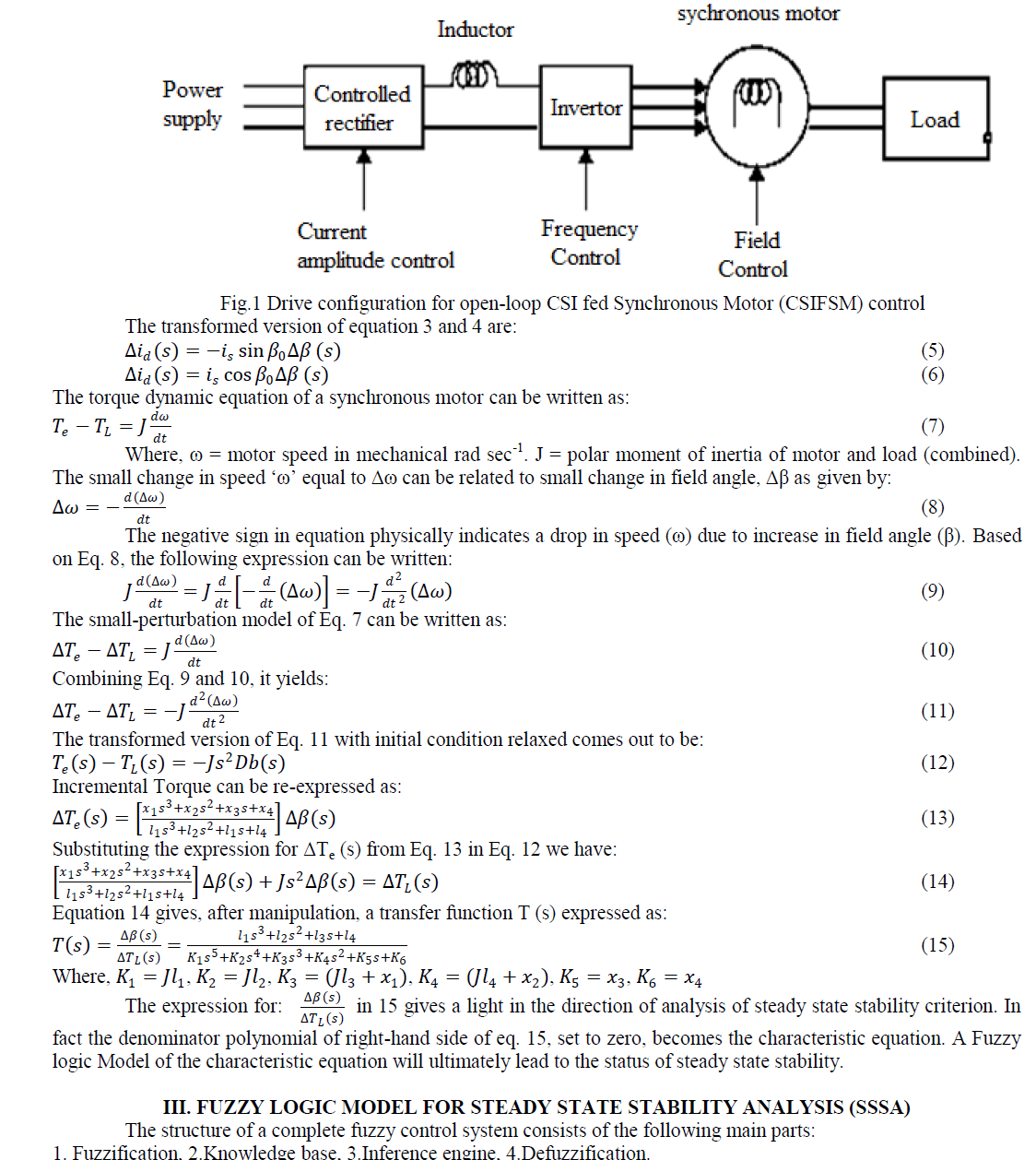 |
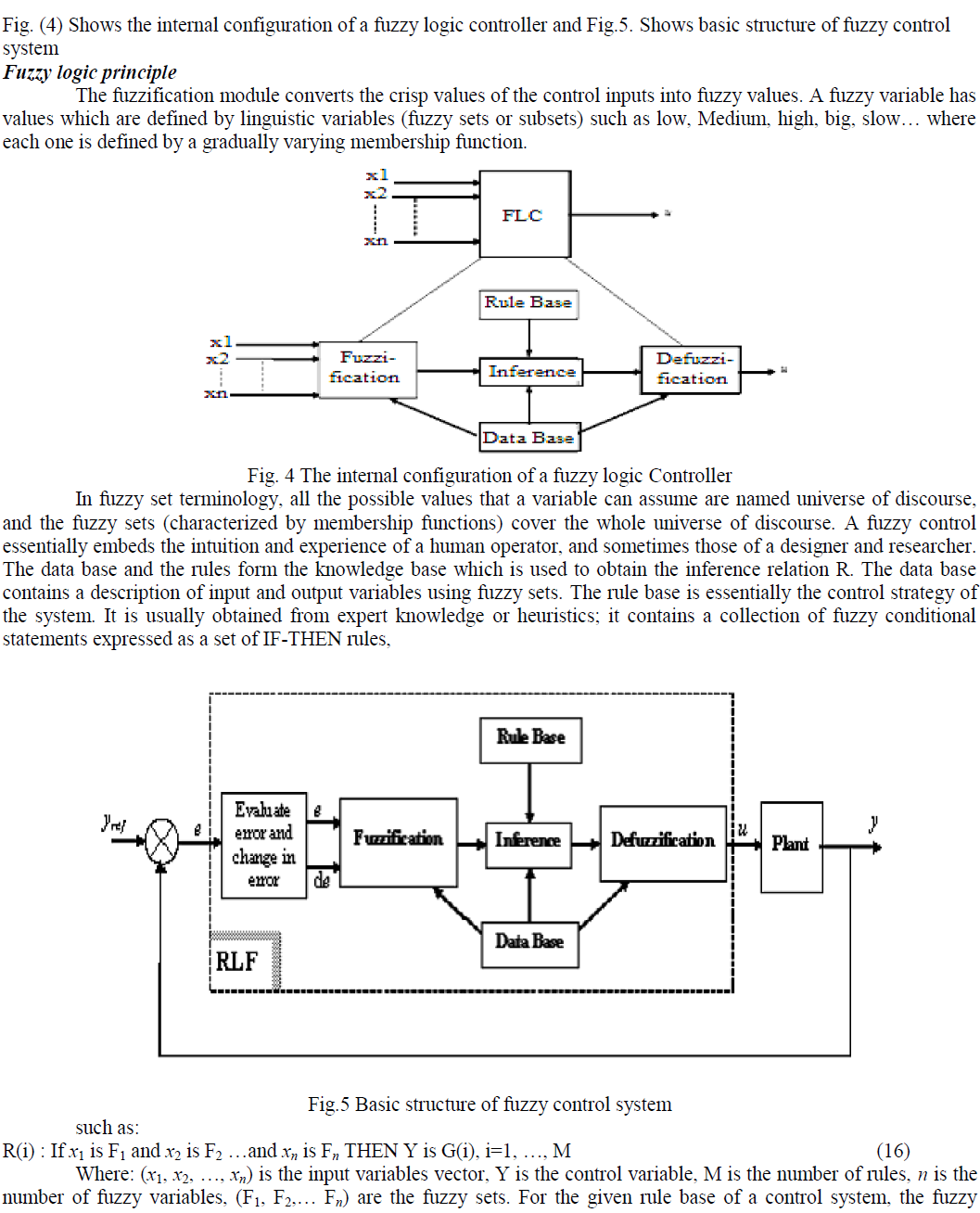 |
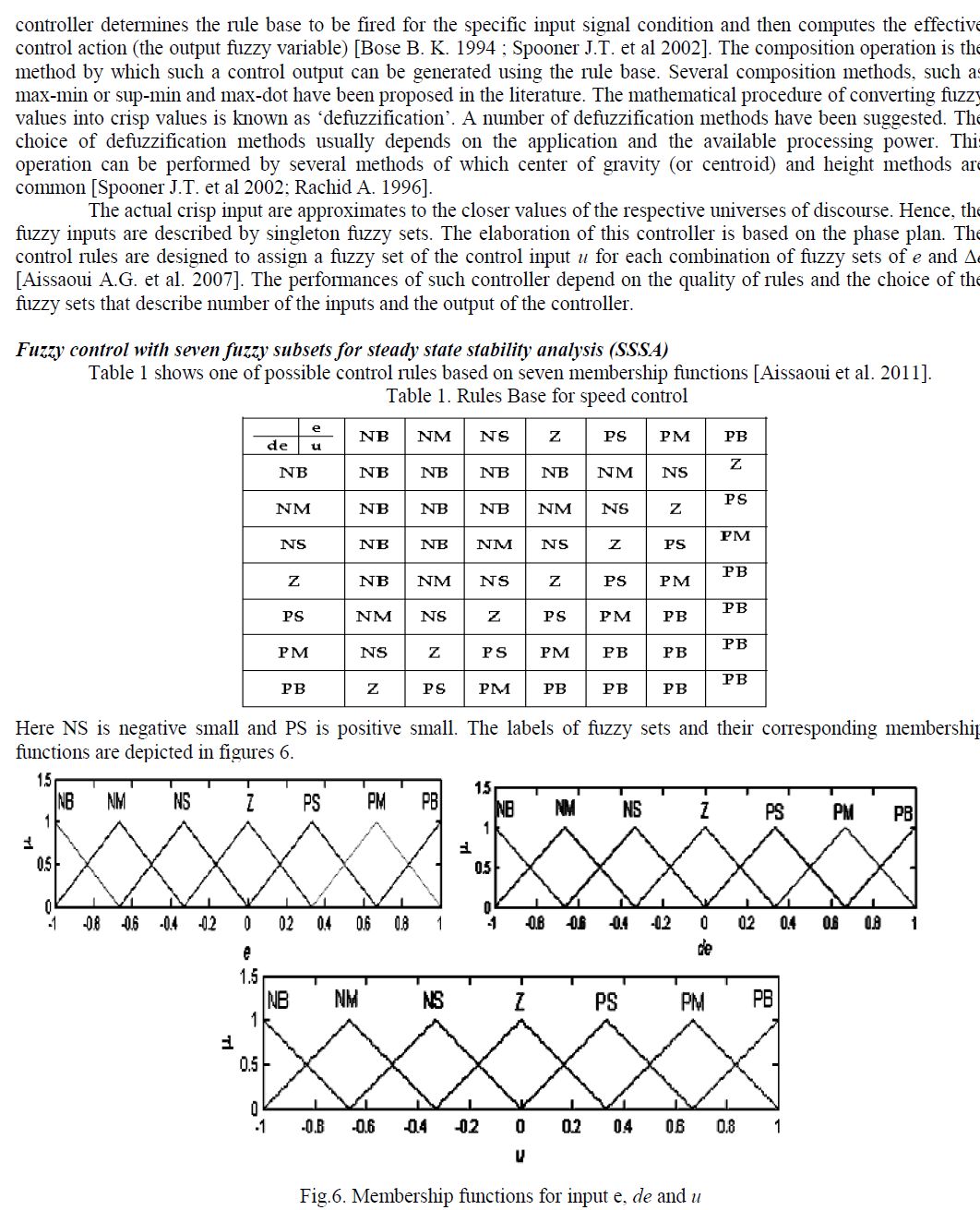 |
| The continuity of input membership functions, reasoning method, and defuzzification method for the continuity of the mapping ufuzzy (e,e’) is necessary. In this paper, the triangular membership function, the max-min reasoning method, and the center of gravity defuzzification method are used, as those methods are most frequently used in many literatures [Bose B. K. 1994; Rachid A. 1996 ]. |
DESCRIPTION OF MACHINE DRIVE |
| The schematic diagram of the steady state stability analysis (SSSA) Model under study of CSI fed Synchronous Motor (CSIFSM) is shown in Fig.7. The power circuit consists of a continuous voltage supply which can provided by a six rectifier thyristors and a three phase GTO thyristors inverter whose output is connected to the stator of the CSI fed Synchronous Motor (CSIFSM). The field current i f of the CSI fed Synchronous Motor (CSIFSM), which determines the field flux level is controlled by voltage vf [Aissaoui, A.G. et al 2010; Namuduri, C. & Sen, P. C. 1987]. |
| The parameters of the CSI fed Synchronous Motor (CSIFSM) are: Rated output power 3HP, Rated phase voltage 75V, Rated phase current 15 A, Rated field voltage vf=2.5V, Rated field current if =40A, Stator resistance Rs =0.295Ω, Field resistance Rf =0.055Ω, Direct stator inductance Lds =9.5 mH, Quadrature stator inductance Lqs=4.5 mH, Field leakage inductance Lf=7.9 mH, Mutual inductance between inductor and armature Mfd=6.96mH, The damping coefficient B =0.008 N.m/s, The moment of inertia J =0.06 kg.m2, Pair number of poles p = 2. Fig.7 shows the schematic diagram of the speed control of CSI fed Synchronous Motor (CSIFSM) using fuzzy logic controller. |
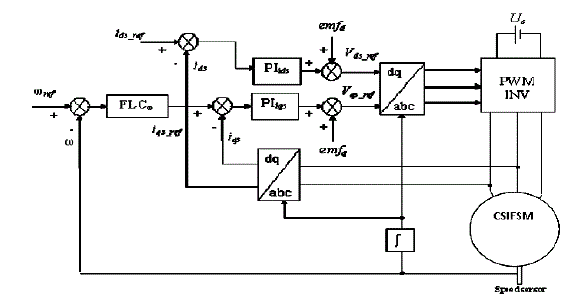 |
| Fig.7. System Configuration of Field-Oriented CSI fed Synchronous Motor (CSIFSM) Control. |
STEADY STATE STABILITY ANALYSIS (SSSA) OF CSI FED SYNCHRONOUS MOTOR (CSIFSM) |
| This section deals with steady state analysis of PWM signal fed, synchronous motor. Using fuzzy logic theory considering mathematical model, performance characteristics of the drive under steady state are, obtained for comparison, corresponding performance. Characteristics of the motor when fed from sinusoidal supply are also presented. |
| Equivalent circuit approach for predetermination of the steady state performance of the synchronous motor is well suited, when the input voltage is sinusoidal. However, when the motor voltage is non-sinusoidal, as in the case of present drive, it is more convenient to Work out the performance in time domain on instantaneous basis. The modulating wave and a carrier wave voltage of a particular carrier ratio are generated and the signals obtained by comparing them are used to trigger various PWM inverter devices. The PWM voltage is considered as forcing function to the coupled circuit Model of induction motor and waveforms of the motor current are obtained m time domain. This requires the mathematical model of the drive to be solved through numerical techniques. From the initial standstill conditions the motor is allowed to build up under a given load torque until steady state is reached. The steady state is identified when the motor current waveform successively exhibits identical cycles. The voltage-current waveforms are then used to compute the steady-state performance in time-domain. This analysis is carried out at a selected frequency of 50 Hz and at no and full load condition. |
| Stability Control System Structure |
| The general stability model of the proposed CSI fed Synchronous Motor (CSIFSM) drive is shown in Fig. 7. Unlike the fixed dc-link current scheme, this scheme varies the dc-link current, in order to keep the CSI modulation index constant in steady state. The global control strategy is composed of two main control loops. The first control loop is the motor speed control (ɷm) based on a slip speed regulator, which sets the slip speed reference (ɷs1) . The synchronous speed (ɷms) , obtained by adding the actual speed and the slip speed, determines the inverter frequency (fl) . The motor voltage reference signal (Vl,ref) is constructed from the frequency using a function generator, which ensures a nearly constant flux operation. Finally, the voltage controller and the space-vector modulator produce the switching pattern ([Si]) based on the difference between the sine voltage reference waveforms (vl,ref) and the sampled load voltage waveforms (vl) . This feedback scheme ensures that the CSI gating pattern is modified on-line, so as to force the output voltage (vl) to track the reference (vl,ref) , thereby resulting in a fast dynamic response, with rise times in the range of the sampling period( tsample) of the space-vector technique. The second control loop is the PWM CSI modulation index Loop (mi) . The main function of this slower loop is to set online the dc-link current reference (idc,ref) in such a way that the steady-state PWM CSI modulation index remains equal to the reference (mi,ref). It is well known that a synchronous motor is unable to self-start when supplied with a constant frequency source. The starting torque of the CSI fed Synchronous Motor (CSIFSM) used in this research is provided by a rotor squirrel cage winding. The starting process of the CSI fed Synchronous Motor (CSIFSM) drive can be considered as a superposition of two operating modes, namely: 1) unsymmetrical asynchronous motor mode and 2) magnet-excited asynchronous generator mode. |
| Controller Models |
| 1) Fuzzy Speed Controller: The block diagram of the FLC, which is utilized as a speed controller in this work, is shown in Fig.8. In this normalized FLC, the present sample of the speed error Δω(n) and the present sample of the change of speed error Δe(n) are the inputs. The present sample of the q-axis command current i∗ q(n) is the output. Six rules were used for the proposed FLC. Various scaling factors (kω, ke, and ki) for the FLC were tuned by trial and error to get an optimum drive performance. The FLC was normalized so that it can be used for different ratings and different types of motors. |
| 2) Current Controller: Two independent sinusoidal band hysteresis current controllers are used to force phases “a” and “b” currents to follow their commands. These commands are generated from the vector control and speed control loops. The outputs of the controllers are in the form of four logics. Those logics are used to switch ON and OFF the inverter power switches. For the proposed control scheme, the d-axis component of the stator current id is set to zero in order to control the motor up to the rated speed. |
 |
| Fig.8. Fuzzy speed controller Construction |
SYSTEM EQUATIONS UNDER STEADY STATE |
| In case of sinusoidal input to the motor, motor voltages and currents attain steady ac values under steady state. When referred to synchronously rotating d-q reference frame they appear to be dc quantities and their time derivative becomes zero. However in case of PWM inverter fed induction motor drive the input voltage is non-sinusoidal and therefore for steady state. The dynamic equations of the motor that are nonlinear may be solved by numerical analysis method to get steady state currents. |
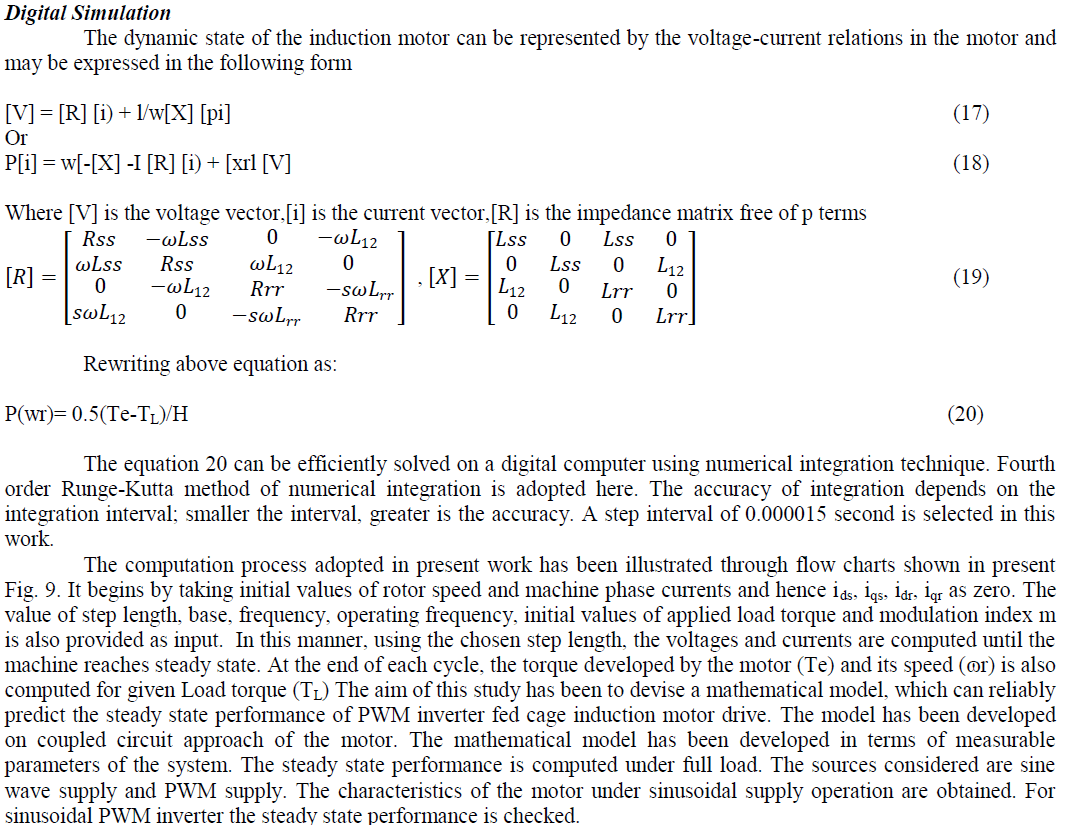 |
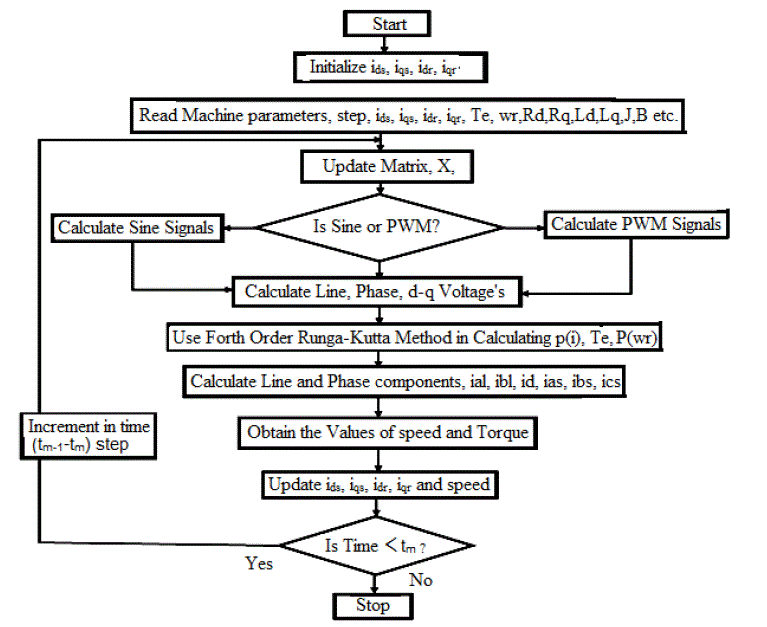 |
| Fig.9 Flow charts for calculating steady state stability analysis (SSSA) |
RESULTS AND DISCUSSIONS |
| The performances of the proposed FLC-based CSI fed Synchronous Motor (CSIFSM) have been investigated extensively both in simulation and experiment at different dynamic operating conditions. Sample results are presented below. Fig.10 shows the starting responses of the proposed CSI fed Synchronous Motor (CSIFSM) drive in simulation. It is seen in Fig. 10(a) and the effectiveness of the FLC is proven by no overshoot, no undershoot, and zero steady-state error of the speed response. It is also seen in Fig. 10 that the steady-state phase currents, its harmonic distortion, and the torque response of the proposed CSI fed Synchronous Motor (CSIFSM) drive are also comparable to those of the conventional drive. The torque ripple is a little bit higher in the proposed inverter but still in the acceptable range. The robustness of the proposed FLC-based CSI fed Synchronous Motor (CSIFSM) drive is also verified in simulation for a sudden change in command speed, and for a change in load, which are shown in Fig.11. In Fig. 11, the motor was initially loaded at 0.55 N · m and at t = 0.32 s, the load was suddenly increased to 2.1 N · m, and at t = 0.61 s, the load was again decreased back to 0.52 N · m. It is evident in Fig. 11(b) that there is a steady-state speed error for the lightload conditions. This is probably because of too much control action of the FLC, as the control action for the FLC was designed for the rated-load condition. However, the steady-state error is almost negligible. The performance of the proposed drive is also tested for the speed reversal case, which is shown in Fig. 12. It is shown that the drive can successfully reverse the speed almost accurately and quickly. The experimental starting responses including speed phase current ia, steady-state currents ia, ib and ia, ic, and the harmonic spectrum of ia at rated speed are shown in Fig. 12. Fig. 12(a) shows that the actual speed of the proposed drive is following the command speed without steady-state error, which, in turn, validates the simulation results. For safe operation, the voltage was applied to the inverter as quickly as possible through variac and rectifier arrangements. Due to the limitation of two channels of the oscilloscope, the transient stator current was stored in another start-up condition of the motor. The correlation between the transient speed response shown in Fig. 13(a) and current response shown in Fig. 13(b) is a bit different in terms of the transient times since the voltage was applied through a variac manually at different times. For the same limitation of the oscilloscope, two of the steady state stator currents were stored at a time, which is shown in Fig. 13(b) and (c). The steady-state currents indicate the balanced operation of the inverter. It is seen in Figs. 13 that the performance of the proposed fuzzy based CSI fed Synchronous Motor (CSIFSM) drive is much closer to the conventional three-phaseinverter- fed drive. The robustness of the proposed drive is further verified by experimental speed responses for a step of change in command speed and step increase in load as shown in Fig.14. In Fig.14(a), the motor was running initially at 140 rad/s with a load of 1.5 N · m and then an online step increase of reference speed from 140 to 200 rad/s was applied. In Fig.14 (b), |
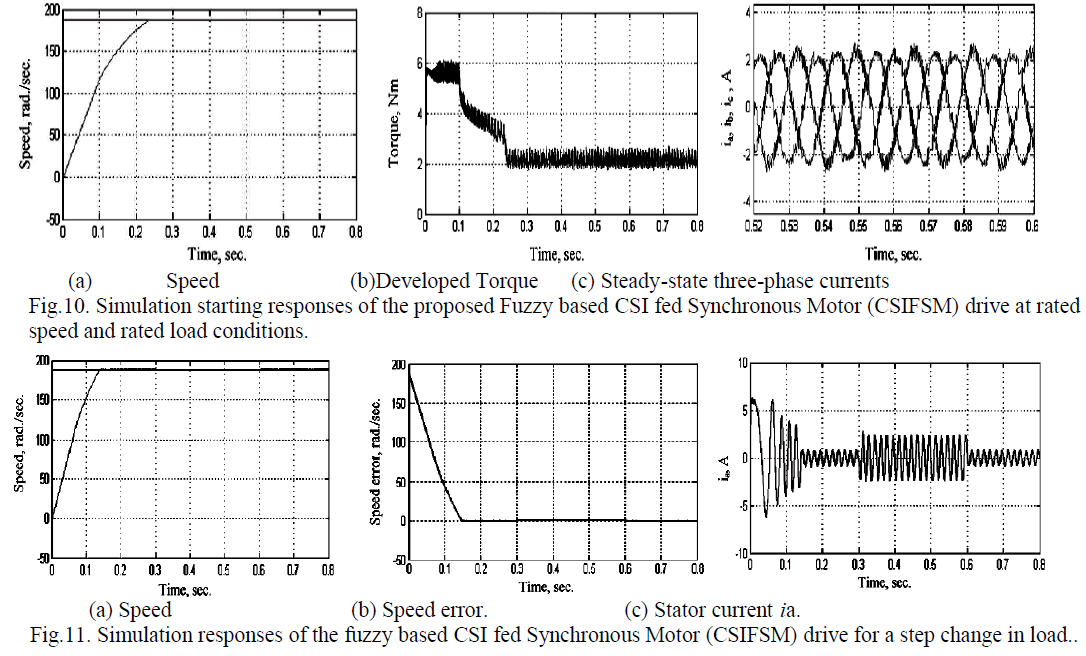 |
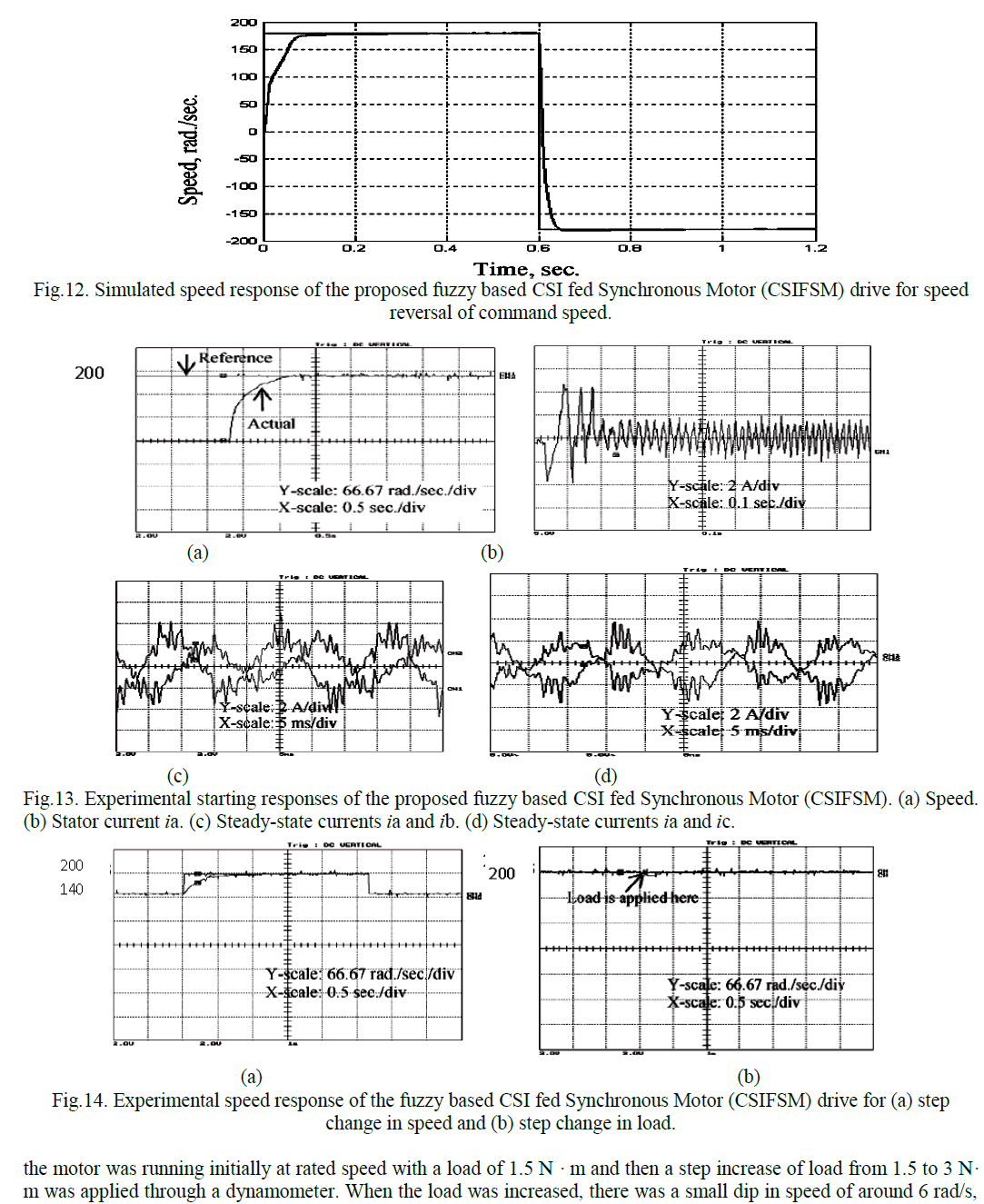 |
| but the drive quickly recovered the rated speed. It is evident in Fig. 14(a) and (b) that the drive is capable of handling the online step changes in reference speed and almost insensitive to load disturbances in real time. Thus, the proposed fuzzy based CSI fed Synchronous Motor (CSIFSM) drive system has been found robust and cost effective for industrial applications. |
CONCLUSION |
| A CSI fed Synchronous Motor (CSIFSM) drive incorporating an FLC has been developed and simulated. The proposed CSI fed Synchronous Motor (CSIFSM) drive found to be improved steady state stability. The incorporation of FLC as a speed controller enhances the robustness of the drive. In order to verify the robustness of the proposed approach, the performances of the proposed FLC-based CSI fed Synchronous Motor (CSIFSM) drive have been investigated at different operating conditions. A comparison of performances for the proposed fuzzy based CSI fed Synchronous Motor (CSIFSM) motor drive with a conventional drive has also been made in terms of the stator current and speed response under identical operating conditions. The proposed fuzzy based CSI fed Synchronous Motor (CSIFSM) drive has been found robust and acceptable for high-performance industrial variable speed- drive applications considering its high steady state stability and other inherent advantageous features. The simulation results show that the proposed FLC-based CSI fed Synchronous Motor (CSIFSM) is superior to conventional system in robustness and in tracking precision. The simulation study indicates clearly the superior performance of FLC, because it is adaptive in nature. It appears from the response properties that it has a high performance in presence of the uncertain plant parameters and load disturbances. It is used to control system with unknown model. The steady state stability analysis (SSSA) of CSI fed Synchronous Motor (CSIFSM) by FLC gives fast dynamic response with no overshoot and negligible steady-state error. |
References |
|